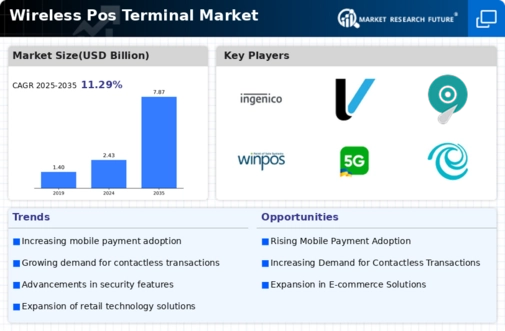Market Share
Wireless Pos Terminal Market Share Analysis
In the fiercely competitive landscape of the Wireless POS Terminal market, companies deploy various market share positioning strategies to establish and strengthen their presence. One pivotal strategy involves product differentiation. Companies aim to distinguish their wireless POS terminals by offering unique features, advanced functionalities, and user-friendly interfaces. This approach allows them to carve a niche in the market and attract businesses looking for specific capabilities, whether it's seamless integration with other systems, enhanced security features, or compatibility with emerging payment technologies.
Another crucial aspect of market share positioning is pricing strategy. Companies strategically set their prices to appeal to different segments of the market. Some may adopt a cost leadership strategy, offering more affordable wireless POS terminals to target price-sensitive businesses. Others may position themselves as premium providers, focusing on delivering high-end features and superior performance, and charging a premium accordingly. Striking the right balance between pricing and perceived value is essential for companies aiming to capture and maintain a significant market share.
Market expansion is also a key strategy in the wireless POS terminal market. Companies seek to broaden their market reach by entering new geographical regions or targeting different industry verticals. This expansion can be achieved through partnerships, collaborations, or establishing a robust distribution network. By diversifying their customer base, companies reduce dependency on specific market segments, mitigating risks and enhancing their overall market position.
Strategic alliances and partnerships play a vital role in market share positioning. Collaborating with other businesses, software providers, or payment processors can lead to innovative solutions that offer a comprehensive package to customers. These partnerships not only strengthen the product offering but also enhance the market presence of companies involved, creating a mutually beneficial scenario. Through such collaborations, companies can leverage each other's strengths to gain a competitive edge and increase market share.
Moreover, continuous innovation is a cornerstone of successful market share positioning in the wireless POS terminal market. Companies invest in research and development to stay ahead of technological trends and consumer demands. This innovation can involve the introduction of cutting-edge hardware, the integration of advanced software solutions, or the incorporation of emerging technologies such as AI and machine learning. By consistently offering upgraded and innovative products, companies can capture the attention of tech-savvy businesses and maintain a competitive position in the market.
Strategies related to customer engagement and satisfaction also play a significant role in market share positioning. Building strong relationships with customers through effective communication, excellent customer support, and responsive service can lead to customer loyalty. Satisfied customers are more likely to recommend a product, fostering positive word-of-mouth marketing and contributing to market share growth. Companies that prioritize customer experience gain a competitive advantage and position themselves as preferred choices in the market.
Furthermore, flexibility and adaptability are critical strategies for market share positioning. The wireless POS terminal market is dynamic, with evolving technologies and changing consumer preferences. Companies that can quickly adapt to these changes, update their offerings, and embrace emerging trends are better positioned to capture market share. Agility in responding to market dynamics allows companies to stay relevant and meet the evolving needs of businesses across various industries.








Leave a Comment